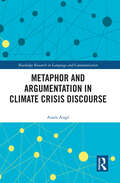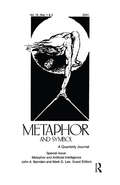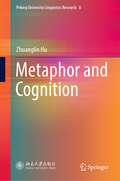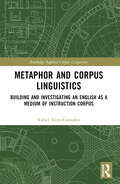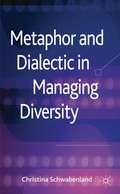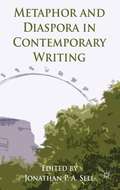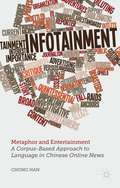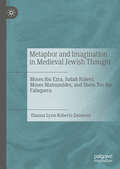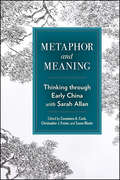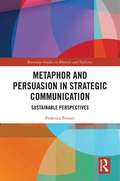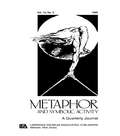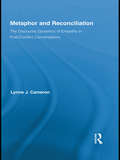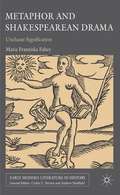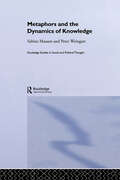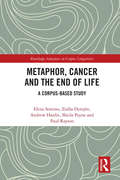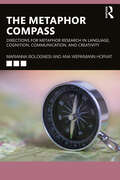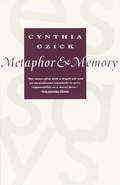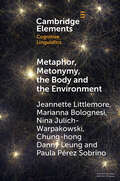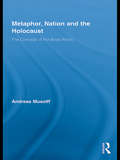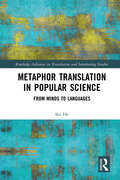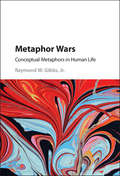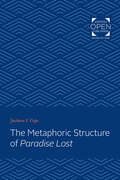- Table View
- List View
Metaphor and Argumentation in Climate Crisis Discourse (Routledge Research in Language and Communication)
by Anaïs AugéThis volume sheds light on the argumentative role of metaphor in climate change discourse, unpacking the ways in which stakeholders use specific metaphors to influence perceptions of the climate crisis. While existing research has explored the explanatory function of metaphors in communication on climate change, this book offers an alternative view, one which posits that metaphors can go beyond disseminating scientific observations to promoting biases in the depiction of these observations. Augé analyses oft-used ideas in climate change communication, such as greenwashing, drawn from a wide-ranging corpus spanning media discourse, scientific discourse, NGO communications, political speech, and social media messages in English. The book presents an overview of different arguments conveyed through metaphors around five key themes—climate change mitigation; the evolution of climate change; global and local effects; the significance of climate change in specific countries; and the relationship between climate change and other contemporary social issues. The volume highlights how the complexity of climate change often necessitates the use of metaphor and the value of further research on the argumentative function of metaphor in elucidating its ideological dimensions in climate crisis discourse. This book will be of interest to scholars in discourse analysis, corpus linguistics, cognitive linguistics, and environmental communication.
Metaphor and Artificial Intelligence: A Special Double Issue of metaphor and Symbol
by John M. KennedyThis special issue arose out of a symposium on metaphor and artificial intelligence in which the main orientation was computational models and psychological processing models of metaphorical understanding. The papers in this issue discuss: *implemented computational systems for handling different aspects of metaphor understanding; *how metaphor can be accommodated in accepted logical representational frameworks; *psychological processes involved in metaphor understanding; and *the cross-linguistic cognitive reality of conceptual metaphors.
Metaphor and Cognition (Peking University Linguistics Research #8)
by Zhuanglin HuThis book collects virtually all research perspectives on metaphor in the field of cognitive linguistics. Moreover, it presents a comprehensive range of research methods for metaphor including qualitative and quantitative methods and the combination of the two. For example, critical metaphor analysis, metaphor interpretation, metaphor experiments, neuro method, and so on are all explained in detail.
Metaphor and Corpus Linguistics: Building and Investigating an English as a Medium of Instruction Corpus (Routledge Applied Corpus Linguistics)
by Rafael Alejo-GonzálezMetaphor and Corpus Linguistics: Building and Investigating an English as a Medium of Instruction Corpus offers a model for building a corpus of oral EMI seminars. It demonstrates how incorporating metaphor to the process of corpus building affords a more comprehensive description of the role of metaphor in discourse. EMI is the specific context outlined in this volume, and as such it will be of particular interest to researchers in this area, though the design and model can be easily generalised and applied to other corpora focusing on metaphor. Alejo-González argues for the need to build such a corpus given the scarcity of corpora being tagged for metaphor as well as the shortage of those dealing with the EMI phenomenon. This book will be of practical use and interest to those researchers of corpus linguistics or related areas looking to explore metaphor through their corpus studies.
Metaphor and Dialectic in Managing Diversity
by Christina SchwabenlandMetaphor and dialectic are modes of thinking that influence the ways in which we identify what we have in common with others, how we differ and how we manage this diversity to achieve organizational goals. This book explores how we can become more aware of these unconscious processes and challenge stereotypes.
Metaphor and Diaspora in Contemporary Writing
by Jonathan P. A. SellChoose ten major contemporary diasporic writers (from Abdulrazak to Zadie), ask ten leading authorities to write about their use of metaphor, and this is the result: a timely reassertion of metaphor's unrivalled capacity to encompass sameness and difference and create understanding and empathy across boundaries of nationality, race and ethnicity.
Metaphor and Entertainment
by Chong HanMetaphor and Entertainment presents the very first, large-scale exploration of metaphor in Chinese online entertainment news, one of the most vibrant and controversial news genres in contemporary China.
Metaphor and Imagination in Medieval Jewish Thought: Moses ibn Ezra, Judah Halevi, Moses Maimonides, and Shem Tov ibn Falaquera
by Dianna Lynn Roberts-ZaudererThis book reveals how Moses ibn Ezra, Judah Halevi, Moses Maimonides, and Shem Tov ibn Falaquera understood metaphor and imagination, and their role in the way human beings describe God. It demonstrates how these medieval Jewish thinkers engaged with Arabic-Aristotelian psychology, specifically with regard to imagination and its role in cognition. Dianna Lynn Roberts-Zauderer reconstructs the process by which metaphoric language is taken up by the imagination and the role of imagination in rational thought. If imagination is a necessary component of thinking, how is Maimonides’ idea of pure intellectual thought possible? An examination of select passages in the Guide, in both Judeo-Arabic and translation, shows how Maimonides’ attitude towards imagination develops, and how translations contribute to a bifurcation of reason and imagination that does not acknowledge the nuances of the original text. Finally, the author shows how Falaquera’s poetics forges a new direction for thinking about imagination.
Metaphor and Meaning: Thinking Through Early China with Sarah Allan (SUNY series in Chinese Philosophy and Culture)
by Constance A. Cook; Christopher J. Foster; Susan BladerIn Metaphor and Meaning, scholars from China, the United States, and Europe draw on Sarah Allan's groundbreaking application of conceptual metaphor theory to the study of early Chinese philosophy and material culture. Conceptual metaphor theory treats metaphors not just as linguistic expressions but as fundamental structures of thought that define one's conceptual system and perception of reality. To understand another culture's worldview, then, hinges upon identifying the right metaphors, through which it then becomes possible to navigate between shared and unshared experiences. The contributors pursue lines of argument that complement, enhance, or challenge Allan's prior investigations into these root metaphors of early Chinese philosophy, whether by explicitly engaging with conceptual metaphor theory or, more indirectly, by addressing meaning construction in a broader sense. Like Allan's interpretative works, Metaphor and Meaning interrogates both transmitted traditions and newly unearthed archaeological finds to understand how people in early China thought about the cosmos, society, and themselves.
Metaphor and Persuasion in Strategic Communication: Sustainable Perspectives (Routledge Studies in Rhetoric and Stylistics)
by Federica FerrariThis groundbreaking work adopts an alternative metaphor-based approach to challenge, unpack, and redefine our understanding of persuasion and strategic communication and the extents to which they shape political discourse. The book’s theoretical and methodological grounding in metaphor allows for an alternative perspective on strategic communication but also a robust discussion of both persuasion and other kinds of related discursive processes at work in political communication, including narrative, identification, and ideology. The volume integrates case studies from prominent political discourses, including those of George W. Bush, Jr., Tony Blair, and Barack Obama, to highlight the crucial role of persuasion management and sustainability in the public sphere and the ways in which it might inform political action and change in a positive way. Broadening our perception of the possibilities of persuasion and strategic communication, this dynamic volume is key reading for students and scholars in communication studies, political science, rhetoric, and cognitive linguistics.
Metaphor and Philosophy: A Special Issue of metaphor and Symbolic Activity
by Unknown AuthorDuring the last 15 years, cognitive scientists have discovered things about the nature and importance of metaphor that are startling because of their radical implications for metaphor research and because they require us to rethink some of our most fundamental received notions of meaning, concepts, and reason. Many of the theoretical assumptions that guided earlier generations who worked on metaphor have been undermined by this new research, which has profound implications for philosophy. More specifically, the level of methodological sophistication of empirical studies of metaphor has increased markedly, making possible rigorous, detailed analyses of how metaphors actually structure conceptualization and reasoning. In addition, professionals have learned that metaphor is not merely a linguistic phenomenon but more fundamentally a conceptual and experiential process that structures the world. The articles in this special issue make significant contributions to these advances.
Metaphor and Reconciliation: The Discourse Dynamics of Empathy in Post-Conflict Conversations
by Lynne J. CameronSixteen years after her father was killed by an IRA bomb, Jo Berry had her first conversation with the man responsible. She had made a long journey, ‘walking the footsteps of the bombers’ as she put it, determined not to give in to anger and revenge but to try to understand his motivations and perspective. Her preparedness to meet Pat Magee opened up a path to empathy that developed through their conversations over the following years. This book studies their growing understandings of each other by focusing on the rich networks of metaphors that appear in their conversations, and how these evolve in the process of reconciliation. The innovative research method, reported in a rigorous but accessible style, together with the rich and often poignant data, make this book a valuable addition to the study of metaphor and discourse. In uncovering the development of empathy between these two extraordinary people, Cameron illuminates the moral necessity, and the potential rewards, in trying to imagine the world and mind of the Other. Implications are drawn for how mediators in reconciliation contexts might make positive use of metaphor in supporting the dynamics of empathy.
Metaphor and Shakespearean Drama
by Maria Franziska FaheyMetaphor and Shakespearean Drama explores the fruitful and potentiallydisorderly nature of metaphorical utterances in Shakespearean drama. Borrowing its title from Henry Peacham's 1593 warning that 'there be no uncleane or unchast e] signification contained in the Metaphore, ' it explores the worry expressed in Elizabethan rhetoric books that a metaphor might beget illegitimate meanings. Shakespeare's plays demonstrate that a metaphor can indeed generateunruly meanings which, once uttered, have the power to transform a community. Analyses of Othello, Titus Andronicus, Macbeth, King Henry IV Part 1, Hamlet, and The Tempest demonstrate various aspects of metaphoric performance. Theseinclude metaphor's power to import discourses into speech communities; metaphor's sacrificial nature; the relationship between metaphor and equivocation; metaphor's carnivalesque qualities; dead metaphor's ability to haunt living speech; and metaphor'sability to circulate unacknowledged collective fantasies. "
Metaphor and the Dynamics of Knowledge (Routledge Studies in Social and Political Thought)
by Peter Weingart Sabine MaasenThis book opens up a new route to the study of knowledge dynamics and the sociology of knowledge. The focus is on the role of metaphors as powerful catalysts, and the book dissects their role in the construction of theories of knowledge. It is of vital interest to social and cognitive scientists alike.
Metaphor and the Historical Evolution of Conceptual Mapping
by Richard TrimAn investigation of the historical evolution of figurative language within the framework of cognitive linguistics. It examines how and why metaphors evolve through the ages; discusses the role of culture; patterns of metaphor evolution; how many people use particular expressions.
Metaphor and Writing: Figurative Thought in the Discourse of Written Communication
by Philip EubanksThis volume explains how metaphors, metonymies, and other figures of thought interact cognitively and rhetorically to tell us what writing is and what it should do. Drawing on interviews with writing professionals and published commentary about writing, it argues that our everyday metaphors and metonymies for writing are part of a figurative rhetoric of writing - a pattern of discourse and thought that includes ways we categorize writers and writing; stories we tell about people who write; conceptual metaphors and metonymies used both to describe and to guide writing; and familiar, yet surprisingly adaptable, conceptual blends used routinely for imagining writing situations. The book will give scholars a fresh understanding of concepts such as 'voice', 'self', 'clarity', 'power', and the most basic figure of all: 'the writer'.
Metaphor, Cancer and the End of Life: A Corpus-Based Study (Routledge Advances in Corpus Linguistics)
by Elena Semino Zsófia Demjén Andrew Hardie Sheila Payne Paul RaysonThis book presents the methodology, findings and implications of a large-scale corpus-based study of the metaphors used to talk about cancer and the end of life (including care at the end of life) in the UK. It focuses on metaphor as a central linguistic and cognitive tool that is frequently used to talk and think about sensitive and subjective experiences, such as illness, emotions, death, and dying, and that can both help and hinder communication and well-being, depending on how it is used. The book centers on a combination of qualitative analyses and innovative corpus linguistic methods. This methodological assemblage was applied to the systematic study of the metaphors used in a 1.5-million-word corpus. The corpus consists of interviews with, and online forum posts written by, members of three stakeholder groups, namely: patients diagnosed with advanced cancer; unpaid carers looking after a relative with a diagnosis of advanced cancer; and healthcare professionals. The book presents a range of qualitative and quantitative findings that have implications for: metaphor theory and analysis; corpus linguistic and computational approaches to metaphor; and training and practice in cancer care and hospice, palliative and end-of-life care.
The Metaphor Compass: Directions for Metaphor Research in Language, Cognition, Communication, and Creativity
by Marianna Bolognesi Ana Werkmann HorvatThe Metaphor Compass: Directions for Metaphor Research in Language, Cognition, Communication, and Creativity provides a roadmap to navigate the recent findings and cutting-edge research conducted around the world on metaphor, focusing on the following four themes: Metaphor and Linguistic Diversity, Metaphor and Cognition, Metaphor and Communication, and Metaphor and Creativity. The research presented in this book employs a variety of empirical methods, ranging from neuroimaging to corpus analyses and from behavioral experimentation to computational modeling. Divided into four parts, it offers an array of pedagogical material including activities at the ends of the chapters, to help the reader to consolidate the notions discussed in the chapter. This is a useful resource for students, researchers, and scholars of linguistics, communication, anthropology, psychology, and cognitive science looking to learn about figurative language and creativity.
Metaphor & Memory
by Cynthia OzickFrom the author of The Messiah of Stockholm and Art and Ardor comes a new collection of supple, provocative, and intellectually dazzling essays. In Metaphor & Memory, Cynthia Ozick writes about Saul Bellow and Henry James, William Gaddis and Primo Levi. She observes the tug-of-war between written and spoken language and the complex relation between art's contrivances and its moral truths. She has given us an exceptional book that demonstrates the possibilities of literature even as it explores them.
Metaphor, Metonymy, the Body and the Environment: An Exploration of the Factors That Shape Emotion-Colour Associations and Their Variation across Cultures (Elements in Cognitive Linguistics)
by Jeannette Littlemore Marianna Bolognesi Nina Julich Warpakowski Chung-hong Danny Leung Paula Perez SobrinoBy exploring the associations that people make between emotions and colours, looking at how they vary across languages, and exploring the explanations that people provide for the associations that they make, this Element provides insight into the ways in which humans express emotions through colour, and the reasons why they do so. Metaphoric (and metonymic) language and thought play a key role on several levels in the formation of emotion–colour associations, interacting with physical, environmental and social factors. A strong metaphorical connection between the valence of the emotion and the lightness of the colours with which it is associated, and between the intensity of an emotion and the saturation level of the colours with which it is associated is found. However, the strength of this association varies according to the linguistic background of the speaker, and the gender in which the emotion is presented.
Metaphor, Nation and the Holocaust: The Concept of the Body Politic (Routledge Critical Studies In Discourse Ser. #3)
by Andreas MusolffThis book is the first to provide a cognitive analysis of the function of biological/medical metaphors in National Socialist racist ideology and their background in historical traditions of Western political theory. Its main arguments are that the metaphor of the German nation as a body that needed to be rescued from a deadly poison must be viewed as the conceptual basis rather than a mere propagandistic by-product of Nazi genocidal policies culminating in the Holocaust, and that this metaphor is closely related to the more general metaphor complex of the nation as a human body/person, which is deeply ingrained in Western political thought. The cognitive approach is crucial to understanding the nature and the origins of this metaphor complex because it goes beyond the rhetorical level by analyzing the ideological and practical implications of the conceptual mapping body-state in detail. It provides an innovative perspective on the problem of how the Nazis managed to ‘revive’ a clichéd metaphor tradition to the point where it became a decisive factor in European and world history. Musolff reveals how such a perspective allows us to explain why the body-state metaphor continues to be attractive for use in contemporary political theories.
The Metaphor of Celebrity
by Joel DeshayeThe Metaphor of Celebrity is an exploration of the significance of literary celebrity in Canadian poetry. It focuses on the lives and writing of four widely recognized authors who wrote about stardom - Leonard Cohen, Michael Ondaatje, Irving Layton, and Gwendolyn MacEwen - and the specific moments in Canadian history that affected the ways in which they were received by the broader public.Joel Deshaye elucidates the relationship between literary celebrity and metaphor in the identity crises of celebrities, who must try to balance their public and private selves in the face of considerable publicity. He also examines the ways in which celebrity in Canadian poetry developed in a unique way in light of the significant cultural events of the decades between 1950 and 1980, including the Massey Commission, the flourishing of Canadian publishing, and the considerable interest in poetry in the 1960s and 1970s, which was followed by a rapid fall from public grace, as poetry was overwhelmed by greater popular interest in Canadian novels.
Metaphor Translation in Popular Science: From Minds to Languages (Routledge Advances in Translation and Interpreting Studies)
by Sui HeThis book explores the intersection of metaphor studies and translation studies, specifically focusing on popular scientific articles.The volume complements existing work on conceptual metaphor theory in translation by aligning it with conceptual blending theory to demonstrate how an integrated approach offers a more expansive understanding of the cognitive and linguistic dimensions of metaphor translation. It includes an essential introduction to the key concepts and theories in metaphor studies and metaphor translation research, discerning the importance of localising theories from neighbouring disciplines, such as metaphor studies, for advancing interdisciplinary research in translation studies. Sui He applies this approach to popular cosmological discourse, analysing examples from articles in Scientific American and their Chinese translations, allowing for a nuanced examination of translation strategies adopted by translators at both cognitive and linguistic levels, which presents the circulation and transformation of popular cosmological knowledge from English in two Chinese-mediated communities.This book will be of interest to students and scholars in translation studies, metaphor studies, and discourse analysis.
Metaphor Wars
by Gibbs Raymond W. Jr.The study of metaphor is now firmly established as a central topic within cognitive science and the humanities. We marvel at the creative dexterity of gifted speakers and writers for their special talents in both thinking about certain ideas in new ways, and communicating these thoughts in vivid, poetic forms. Yet metaphors may not only be special communicative devices, but a fundamental part of everyday cognition in the form of 'conceptual metaphors'. An enormous body of empirical evidence from cognitive linguistics and related disciplines has emerged detailing how conceptual metaphors underlie significant aspects of language, thought, cultural and expressive action. Despite its influence and popularity, there have been major criticisms of conceptual metaphor. This book offers an evaluation of the arguments and empirical evidence for and against conceptual metaphors, much of which scholars on both sides of the wars fail to properly acknowledge.
The Metaphoric Structure of Paradise Lost
by Jackson I. CopeOriginally published in 1962. The rise of "metaphoric" criticism is a reaction against a previous critical preoccupation with psychology and time. Milton spatialized time, thoroughly mastering a metaphoric technique. The Metaphoric Structure of Paradise Lost, after discussing the influences that shaped Milton's aesthetic, systematically examines the structural components of Paradise Lost—light, darkness, and vertical movement—and finds that they imitate, metaphorically, the overall theme of the epic. To test further the implications of his hypothesis, Professor Cope turns to two unsettled points in Miltonic exegesis: Milton's muse and the dialogue in Heaven.
